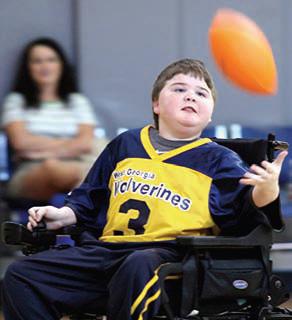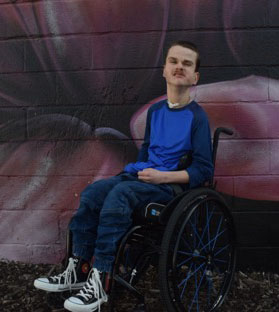Wheelchairs & Adapted Strollers
What You Should Know About Wheelchairs and Adapted Strollers
Wheelchairs
- Promote ability and participation with peers.
- Conserve strength for children who may struggle to walk over longer distances.
- Reduce the risk of caregiver injuries linked to lifting their children.
Strollers
- They are easy to load and unload from cars.
- They tend to fit in places where wheelchairs may not, such as small doorways and hallways.
- They have a more flexible than firm seat, adding to sacral pressure.
- Children often need caregivers to push their strollers, but children may learn to drive manual or power wheelchairs on their own.
 425 KB) by
AbleData.
425 KB) by
AbleData.
Getting the First Wheelchair
Most children walk by 18 months of age. If a child is not mobile on their own by then, it is time to talk about other choices, such as wheelchairs. Some children with motor impairment will need positioning/seating before 18 months. The process should begin whenever a child needs support for function/mobility or a parent needs "another pair of hands."
Getting a wheelchair can be exciting and overwhelming, both emotionally and financially. It can sometimes bring up painful feelings that you may not expect. This may relate to:
- Accepting a diagnosis or a permanent disability
- Worry that your child will be seen as different
- The need to make changes in housing or lifestyles.
Knowing you might have these feelings and working through them can be helpful.
Finding a Physical or Occupational Therapist (PT/OT)
- One for a wheelchair (or other mobility device)
- One for the PT/OT or seating clinic to evaluate the child for a wheelchair and make a full prescription of the best wheelchair or stroller for the child.
Evaluation for a Wheelchair
- The parents and child will steer the team with their thoughts about what may work, what has been tried before, and can point out their needs for support with mobility. At the end of the process, the choices are theirs.
-
The Physical or Occupational Therapist (PT/OT) will
evaluate fine motor skills (hand), gross motor skills (total body),
touch, and movement; seating and positioning; visual perception; oral
motor skills (feeding/swallowing); and mobility needs (self-propelled
manual wheelchair or powered wheelchair with a joy stick/head array) for
mobility.
- They will evaluate the different settings for use (home, car, school, etc.).
- Therapists will also teach parents/caregivers how to use the wheelchair, how to take the wheelchair apart for transit, how to get the child in/out of the wheelchair, and set up training for the child to learn to use the chair.
- The Speech Therapist will evaluate the child's communication skills – is an augmentative communication device needed to help increase their ability to communicate? If so, how will it be used in the wheelchair?
-
Rehabilitation Engineers write prescriptions for the
wheelchair, and other equipment.
- These are often based on recommendations from the PT/OT.
- Sometimes referrals are needed for 3rd party payment.
-
Clinicians should write prescriptions for any other
special health needs.
- Clinicians can help show the need for ventilator trays, and adaptations for transporting oxygen, suction and feeding bags on the wheelchair.
- Often a co-signature by the clinician on a letter of medical necessity (LMN) done by the therapist is needed. (See our Working with Insurance Companies page.)
- It may work to rent a wheelchair when the disability is temporary, such as after a surgery or injury.
- Teachers, rehabilitation counselors, employers, day care providers, respiratory therapists, recreational therapists, nurses, orthotists, friends, and even architects can be useful team members to help decide what accommodations to make at home, school, and other places.
-
The Wheelchair/Seating Vendor's agent will send the
paperwork to Medicaid or other health plan.
- They will get prior approval, order the equipment, build, and deliver it.
- Wheelchair vendors are often certified seating
specialists and have good product information and know-how.
- They can explain the pros/cons of each type of wheelchair to the parents and team.
- They can also give price quotes and cost ranges. Vendors have a repair shop where flat tires and other repairs can be made.
Process
Following the Evaluation, a Letter of Medical Necessity Is Written
- It must be co-signed by the doctor, or a prescription must go with the letter.
- This is sent by the vendor to Medicaid/health plan for prior approval.
Once Approval Has Been Received, the Order Is Made.
- When it is received, a final wheelchair fitting by the team is scheduled to make sure it fits and works for the child.
From Start to Finish, It All Takes about 3 Months.
- Appeals must be done in a timely fashion.
- Check the denial letter for timelines.
- See the Working with Insurance Companies and Appealing Funding Denialsfor assistance in appealing.
Funding
Most wheelchairs or other assistive technologies are covered by Medicaid or private insurance as long as they meet a medical need. In general, wheelchairs can be replaced every 5 years or sooner if medical justification is documented and approved. Modifications to wheelchairs, such as for growth, are usually approved yearly. Some state agencies, charitable organizations, or private funding organizations can assist with the cost of the assessment and/or equipment.
How to Know if a Wheelchair Fits
- Head and upper body are upright and in the center of the seat with or without support
- Shoulders are over the hips and level with each other
- Legs are straight or slightly open
- Lower body is straight, in an even tilt, and all the way back in the seat
- Weight is on the thighs and backside
- Feet are on the footrest
- Knees are no more than 2-3 finger widths in front of the seat edge (for a growing child)
- Skin is healthy and looks unharmed – check the backside near the bottom of the spine and the back of the legs (if the seat is too deep, the child will lean back to reach the support surface, the pelvis will be in a backward tilt, and the child may have redness behind the knees)
- Eyes are forward
- Chest harness fits and does not cut into the neck and is not a choking hazard (the child should not be "hanging" on the harness)
- Wheelchair has a snug fitting seat belt, with padding if needed
- Wheelchair works correctly and is regularly maintained.
- The child is comfortable for at least 2 hours at a time in the chair
Considerations
- If a child has a severe impairment and/or contractures, a wheelchair may not fit as described above. With a fixed position, the seating should accommodate the child’s body. Comfort and good skin health may become the top goals.
- If the wheelchair does not fit the right way, a referral to a PT/OT with seating knowledge should be made to solve the problem or suggest a new chair or other choices. If repairs are needed, the parent should call the vendor. If needed, the doctor should write a prescription/referral for the wheelchair repairs.
Follow-up
Training is essential to maximize the use of the wheelchair or other Assistive Technology (AT) device, and can be provided by the involved PT/OT. The team should follow-up with the individual to ensure the wheelchair is acceptable and meets the needs of the patient and family. It is common to have to make "adjustments" after the wheelchair has been in use for some time.
Periodic Re-evaluation
Resources
Information & Support
In addition to informational links, we provide links to both
not-for-profit and commercial sites offering assistive technology products and
medical equipment that may help you understand the range of technology
available. We do not endorse these companies, nor provide any guarantee of the
quality of equipment available through these sites
For Parents and Patients
Adaptivemall.com
A commercial site offering a variety of strollers, equipment, and assistive technology products.
Assistive Devices (NICHD)
A description of different types of assistive devices with links to additional information and resources from the US Department
of Health & Human Services' (HHS) National Institutes of Health, National Institute of Child Health and Human Development
(NICHD).
Seating and Wheeled Mobility: A Clinical Resource Guide ( 425 KB)
425 KB)
Guide to wheelchairs. Not specific to children but includes information about the pediatric population.
Sample Physician Order for Wheelchair or Adapted Stroller and Seating Evaluation ( 107 KB)
107 KB)
Sample physician order for wheelchair or adapted stroller and seating evaluation.
Services for Patients & Families in Nevada (NV)
| Service Categories | # of providers* in: | NV | NW | Other states (3) (show) | | NM | RI | UT |
|---|---|---|---|---|---|---|---|---|
| Adolescent Health Transition Programs | 1 | 1 | 5 | 1 | 5 | |||
| Assistive Technology Equipment | 46 | 36 | 47 | 44 | 72 | |||
| CSHCN Clinics | 5 | 2 | 4 | 13 | 5 | |||
| Legal Services, General | 36 | 7 | 11 | 10 | 47 | |||
| Local Support Groups, Disability/Diag | 40 | 5 | 19 | 19 | 94 | |||
| Medical Equipment/Supplies | 26 | 20 | 22 | 28 | 39 | |||
| Occupational Therapy | 22 | 1 | 17 | 22 | 37 | |||
| Physical Therapy | 9 | 12 | 7 | 40 | ||||
| Speech - Language Pathologists | 11 | 4 | 23 | 34 | 65 | |||
| Supportive Housing & Residential Care Homes | 3 | 14 | 6 | 32 | ||||
For services not listed above, browse our Services categories or search our database.
* number of provider listings may vary by how states categorize services, whether providers are listed by organization or individual, how services are organized in the state, and other factors; Nationwide (NW) providers are generally limited to web-based services, provider locator services, and organizations that serve children from across the nation.
Helpful Articles
Greer N, Brasure M, Wilt T.
Wheeled Mobility (Wheelchair) Service Delivery.
Agency for Healthcare Research and Quality.
Technical Brief Number 9; January 2012.
/ https://effectivehealthcare.ahrq.gov/sites/default/files/related_files...
Report prepared by the Minnesota Evidence-based Practice Center; a review of evidence related to wheelchair service, largely
focused on adult services; highlights many of the payer, reimbursement, consumer, and provider issues that are relevant also
for children.
Corbet, Barry.
Spinal Network: The Total Wheelchair Resource Book.
Third Edition ed. Nine Lives Press;
2002.
0971522308
A comprehensive guide to practical information regarding living in a wheelchair.
Butler C, Okamoto GA, McKay TM.
Motorized wheelchair driving by disabled children.
Arch Phys Med Rehabil.
1984;65(2):95-7.
PubMed abstract
Butler C, Okamoto GA, McKay TM.
Powered mobility for very young disabled children.
Dev Med Child Neurol.
1983;25(4):472-4.
PubMed abstract
Tefft D, Guerette P, Furumasu J.
Cognitive predictors of young children's readiness for powered mobility.
Dev Med Child Neurol.
1999;41(10):665-70.
PubMed abstract
Huang HH, Galloway JC.
Modified ride-on toy cars for early power mobility: a technical report.
Pediatr Phys Ther.
2012;24(2):149-54.
PubMed abstract / Full Text
Nelson VS.
Durable medical equipment for children with spinal cord dysfunction: implications of age and level of injury.
J Spinal Cord Med.
2007;30 Suppl 1:S172-7.
PubMed abstract / Full Text
Rodby-Bousquet E, Hägglund G.
Use of manual and powered wheelchair in children with cerebral palsy: a cross-sectional study.
BMC Pediatr.
2010;10:59.
PubMed abstract / Full Text
Tefft D, Guerette P, Furumasu J.
The impact of early powered mobility on parental stress, negative emotions, and family social interactions.
Phys Occup Ther Pediatr.
2011;31(1):4-15.
PubMed abstract
Authors & Reviewers
| Author: | Terry Holden, PT |
| Contributing Author: | Dale-Marie Herring, MA |
| Reviewers: | Tina Persels |
| Amanda Butler, MS, MA, LMFT | |
| Jennifer Goldman, MD, MRP, FAAP | |
| Nancy Murphy, MD, FAAP, FAAPMR | |
| Clint Gibson, RN, BSN, CCM |
Page Bibliography
Butler C, Okamoto GA, McKay TM.
Motorized wheelchair driving by disabled children.
Arch Phys Med Rehabil.
1984;65(2):95-7.
PubMed abstract
Butler C, Okamoto GA, McKay TM.
Powered mobility for very young disabled children.
Dev Med Child Neurol.
1983;25(4):472-4.
PubMed abstract
Corbet, Barry.
Spinal Network: The Total Wheelchair Resource Book.
Third Edition ed. Nine Lives Press;
2002.
0971522308
A comprehensive guide to practical information regarding living in a wheelchair.
Greer N, Brasure M, Wilt T.
Wheeled Mobility (Wheelchair) Service Delivery.
Agency for Healthcare Research and Quality.
Technical Brief Number 9; January 2012.
/ https://effectivehealthcare.ahrq.gov/sites/default/files/related_files...
Report prepared by the Minnesota Evidence-based Practice Center; a review of evidence related to wheelchair service, largely
focused on adult services; highlights many of the payer, reimbursement, consumer, and provider issues that are relevant also
for children.
Huang HH, Galloway JC.
Modified ride-on toy cars for early power mobility: a technical report.
Pediatr Phys Ther.
2012;24(2):149-54.
PubMed abstract / Full Text
Nelson VS.
Durable medical equipment for children with spinal cord dysfunction: implications of age and level of injury.
J Spinal Cord Med.
2007;30 Suppl 1:S172-7.
PubMed abstract / Full Text
Rodby-Bousquet E, Hägglund G.
Use of manual and powered wheelchair in children with cerebral palsy: a cross-sectional study.
BMC Pediatr.
2010;10:59.
PubMed abstract / Full Text
Tefft D, Guerette P, Furumasu J.
Cognitive predictors of young children's readiness for powered mobility.
Dev Med Child Neurol.
1999;41(10):665-70.
PubMed abstract
Tefft D, Guerette P, Furumasu J.
The impact of early powered mobility on parental stress, negative emotions, and family social interactions.
Phys Occup Ther Pediatr.
2011;31(1):4-15.
PubMed abstract


 Get More Help in Nevada
Get More Help in Nevada
